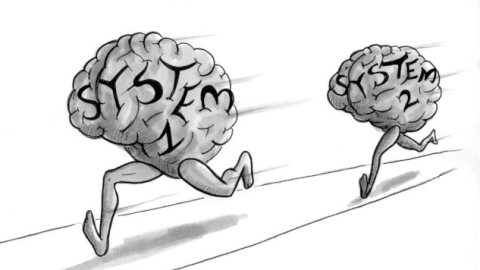Kahneman’s Mind-Clarifying Strangers: System 1 & System 2

Feeling is a form of thinking. Both are ways we process information, but feeling is faster. That’s the crux of Daniel Kahneman’s mind-clarifying work. It won a psychologist an economics Nobel. And strange labels helped.
In Thinking, Fast and Slow, Kahneman wrestles with flawed ideas about decision making. “Social scientists in the 1970s broadly accepted two ideas about human nature. First, people are generally rational…Second, emotions…explain most of the occasions on which people depart from rationality.” But research has “traced [systematic] errors to the… machinery of cognition…rather than corruption…by emotion.”
Kahneman sidesteps centuries of confusion (and Freudian fictions) by using new—hence undisputed—terms: the brilliantly bland “System 1” and “System 2.” These strangers help by forcing you to ask about their attributes. System 1 “is the brain’s fast, automatic, intuitive approach, System 2 “the mind’s slower, analytical mode, where reason dominates.” Kahneman says “System 1 is…more influential…guiding…[and]…steering System 2 to a very large extent.”
The measurable features of System 1 and System 2 cut across prior categories. Intuitive information-processing has typically been considered irrational, but System 1’s fast thinking is often logical and useful (“intuition is nothing more and nothing less than recognition”). Conversely, despite being conscious and deliberate System 2 can produce poor (sometimes irrational) results.
Kahneman launched behavioral economics by studying these systematic “cognitive biases.” He was astonished that economists modeled people as “rational, selfish, with tastes that don’t change,” when to psychologists “it is self-evident that people are neither fully rational nor completely selfish, and that their tastes are anything but stable.”
Kahneman’s potentially paradigm-tipping work has limitations. It is light on evolution, e.g focusing on numerically framed decisions discounts that we didn’t evolve to think numerically. Math is a second nature skill, requiring much System 2 training (before becoming a System 1 skill). Also, we evolved to often act without System 2 consciously deciding (habits are triggered by System 1). Indeed cognitive biases might be bad System 1 habits rather than built in brain bugs. And cognitive biases have two sources of error, the observed behavior and what economists suppose is “rational.”
Those limitations aside, whenever pondering cognition, bear in mind the distinct traits of System 1 and System 2. Mapping mental skills (and the mini-skills they consist of) onto those labels can clarify your thinking about thinking.
Illustration by Julia Suits, The New Yorker Cartoonist & author of The Extraordinary Catalog of Peculiar Inventions.





